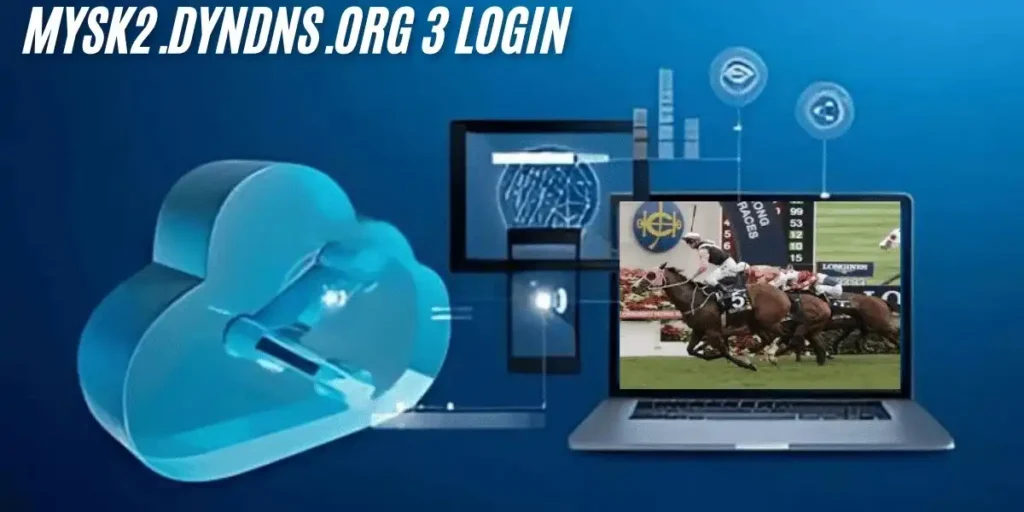In today’s interconnected world, managing remote connections and ensuring that devices are accessible from anywhere is crucial. Dynamic DNS (DDNS) services like Mysk2.dyndns.org 3 allow users to manage IP addresses and ensure they can access devices remotely, even if their IP address changes. Understanding how to use the Mysk2.dyndns.org 3 login process effectively can make all the difference in securing and maintaining reliable access to your network devices.
This guide will take you step by step through the process of logging into Mysk2.dyndns.org 3, ensuring that you understand the necessary steps, potential troubleshooting issues, and how to optimize your network for better remote connectivity.
What is Mysk2.Dyndns.Org 3?
Mysk2.dyndns.org 3 is part of a service offered by DynDNS, a dynamic DNS provider. DDNS is a service that allows users to access their network remotely by providing a constant domain name that updates automatically to reflect any changes in the network’s IP address. This is particularly useful for individuals or small businesses running servers, cameras, or home automation systems that need to be accessed remotely but don’t want the hassle of manually updating IP addresses each time they change.
Mysk2.dyndns.org 3 is likely a personalized or subdomain associated with a specific user’s DDNS account, allowing them to access their devices and servers remotely without needing to remember or deal with changing IP addresses.
Setting Up Your Mysk2.Dyndns.Org 3 Account
Before you can log into Mysk2.dyndns.org 3, it’s important to set up your account with DynDNS and configure your devices properly. Here’s how to get started:
1. Create a DynDNS Account
- Visit the DynDNS website and sign up for a new account.
- Choose a unique subdomain that you can link to your Mysk2.dyndns.org 3 address. This will be the domain name you’ll use to access your devices remotely.
- Follow the account verification process and ensure that your account is active before proceeding.
2. Configure Your Router or Device
- Many modern routers support DDNS functionality natively, which makes configuring your device a straightforward process.
- Navigate to your router’s settings and look for a section labeled DDNS or Dynamic DNS.
- Enter the details provided by DynDNS, including the username, password, and subdomain (which could be mysk2.dyndns.org 3).
- Ensure that your router is set to automatically update the IP address whenever it changes. This ensures you don’t have to manually update your IP address.
3. Install DynDNS Client Software (If Needed)
- Some devices may require a client-side application for DDNS to work smoothly. DynDNS may provide such software to help manage updates.
- Install the client on your computer or device if you have a specific setup that requires it. This software will update your Mysk2.dyndns.org 3 address whenever your device’s IP changes.
How to Log Into Mysk2.Dyndns.Org 3
Now that your account and devices are configured, it’s time to log into Mysk2.dyndns.org 3. The process is relatively simple, but it’s important to follow these steps carefully to ensure a smooth login experience:
1. Open Your Web Browser
- Start by launching your web browser (Chrome, Firefox, Safari, etc.).
2. Enter the Domain Name
- In the address bar, type mysk2.dyndns.org 3. This will direct your browser to the login page associated with your DDNS account.
3. Enter Login Credentials
- On the login page, you will be prompted to enter your username and password. These are the credentials you used when setting up your DynDNS account.
- Ensure that you enter the correct credentials. If you have trouble remembering them, most browsers allow you to save login credentials securely.
4. Access Your Devices
- After logging in successfully, you will be directed to the control panel or dashboard of Mysk2.dyndns.org 3.
- From here, you can manage your devices, check the current IP address, and ensure that your DDNS is working correctly.
Troubleshooting Mysk2.Dyndns.Org 3 Login Issues

While logging into Mysk2.dyndns.org 3 is typically straightforward, you may occasionally encounter issues. Here are some common problems and their solutions:
1. Incorrect Username or Password
- Double-check that you are entering the correct login credentials. If you’ve forgotten your password, use the password recovery option on the DynDNS website to reset it.
2. Browser Compatibility Issues
- Some older browsers may not support the features needed for the DynDNS login page to function properly. Try using a modern browser (Google Chrome, Mozilla Firefox, or Safari) for the best experience.
3. DDNS Configuration Problems
- If your Mysk2.dyndns.org 3 domain isn’t pointing to the correct device, double-check your DDNS settings. Ensure that your router or client software is configured to update your IP address correctly.
4. Network Connection Problems
- If you’re unable to connect to Mysk2.dyndns.org 3, it could be due to network issues or incorrect DNS settings on your router. Ensure that your internet connection is stable and that the router is properly connected to the internet.
5. Expired DynDNS Subscription
- If your Mysk2.dyndns.org 3 service has stopped working, check if your DynDNS account subscription has expired. DynDNS offers both free and paid services, and an expired account may cause login issues.
Benefits of Using Mysk2.Dyndns.Org 3
There are numerous advantages to using a DDNS service like Mysk2.dyndns.org 3 for remote device access:
1. Remote Access
- With DDNS, you can access your home or office network remotely from anywhere in the world. Whether you’re accessing a camera system, server, or any device within your network, the Mysk2.dyndns.org 3 domain ensures that you can connect easily without worrying about IP address changes.
2. No Need for Static IP
- Setting up a static IP can be costly, especially for residential users. DDNS services like DynDNS offer a much more affordable and flexible solution.
3. Improved Security
- With Mysk2.dyndns.org 3, you can configure additional security layers, such as firewalls and authentication protocols, to ensure your network is protected while being remotely accessed.
4. Better Control
- The dynamic nature of DDNS gives you more control over your network, as you can modify settings as needed without the hassle of constantly adjusting your IP address.
Optimizing Your Mysk2.Dyndns.Org 3 Connection
To get the most out of your Mysk2.dyndns.org 3 login, consider these optimization tips:
1. Regularly Check Your DDNS Settings
- Make sure that your DDNS service is running smoothly by periodically checking your router’s DDNS configuration page. This ensures that the service is updating correctly.
2. Use Strong Passwords
- To enhance the security of your Mysk2.dyndns.org 3 login, use a strong password that includes a combination of letters, numbers, and special characters.
3. Enable Two-Factor Authentication
- If supported, enabling two-factor authentication (2FA) for your DynDNS account can add an extra layer of security to your Mysk2.dyndns.org 3 login.
4. Monitor Your Network’s IP Address
- Even though Mysk2.dyndns.org 3 handles IP updates automatically, it’s always a good idea to monitor your IP address through the DynDNS dashboard or other network monitoring tools to ensure everything is functioning correctly.
Download For iOS
To easily access Mysk2.dyndns.org 3 from your iOS devices, follow these steps:
- Visit the App Store: Open the App Store on your iPhone or iPad.
- Search for a DDNS Client: Look for a compatible DDNS client app (such as DynDNS or a third-party DDNS app).
- Download and Install: Tap on the “Download” button to install the app on your device.
- Open the App: Once installed, open the app to begin setup.
- Log In: Enter your DynDNS credentials (username and password) to access your account.
- Configure Settings: Follow the instructions to link your Mysk2.dyndns.org 3 domain with the app.
- Manage Remotely: You can now update your IP, manage devices, and access your network remotely, all from your iOS device.
Also read: VJIT Student Login | Wallpaper:hjotduwi72m= Thanksgiving | woman:yzugckinmmk= beach Guide
Conclusion: Mysk2.Dyndns.Org 3 Login
The Mysk2.dyndns.org 3 login process is a simple yet powerful tool for managing remote access to your devices and networks. By setting up your account, configuring your devices, and following the login steps outlined in this guide, you can easily manage your remote connections without the headache of dealing with changing IP addresses. Moreover, by troubleshooting common issues and optimizing your DDNS setup, you can ensure a secure and reliable experience for years to come.
Whether you are an individual looking to manage your home network or a small business owner in need of remote access to critical systems, Mysk2.dyndns.org 3 offers an affordable and effective solution. By following the steps outlined above, you will be well-equipped to get the most out of this dynamic DNS service and ensure seamless connectivity.
Frequently Asked Questions (FAQ)
1. How Do I Log Into Mysk2.Dyndns.Org 3?
To log into Mysk2.dyndns.org 3, open your web browser and enter the domain name mysk2.dyndns.org 3 in the address bar. Then, enter your DynDNS username and password to access your devices and settings.
2. What Do I Do if I Forget My Login Credentials?
If you’ve forgotten your login credentials, visit the DynDNS website and use the password recovery feature. Follow the prompts to reset your password. If you’ve forgotten your username, check the confirmation email you received when you first registered or reach out to DynDNS support for assistance.
3. How Do I Set Up DynDNS for Mysk2.Dyndns.Org 3?
To set up Mysk2.dyndns.org 3, follow these steps:
Create a DynDNS account.
Choose your unique subdomain (e.g., mysk2.dyndns.org 3).
Configure your router or device with the DynDNS settings (username, password, and subdomain).
Ensure automatic IP address updates are enabled on your router or with the DynDNS client software.
4. What Should I Do If My Mysk2.Dyndns.Org 3 Domain is Not Updating?
If your Mysk2.dyndns.org 3 domain isn’t updating, verify the following:
Check that your router’s DDNS settings are correctly configured.
Make sure your router supports DDNS and is properly connected to the internet.
If you use client software for DDNS, ensure it is running correctly.
Review your DynDNS account to ensure the service is active.



